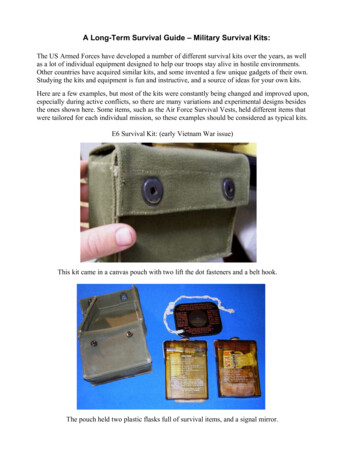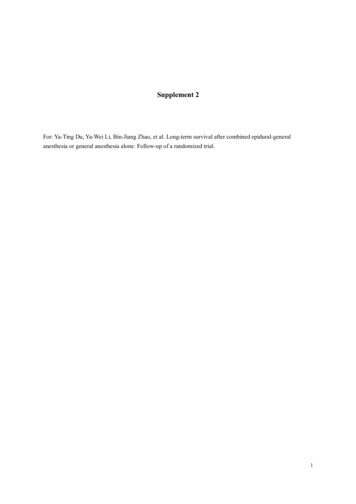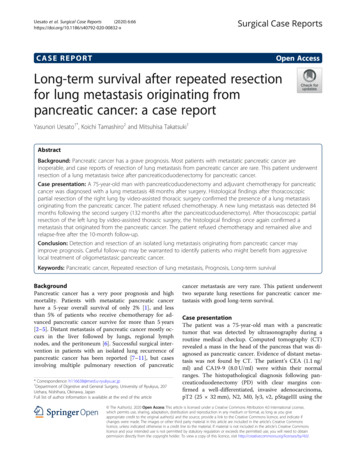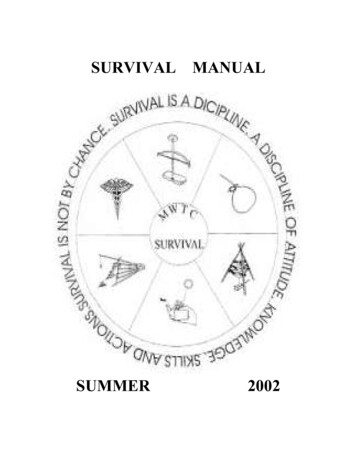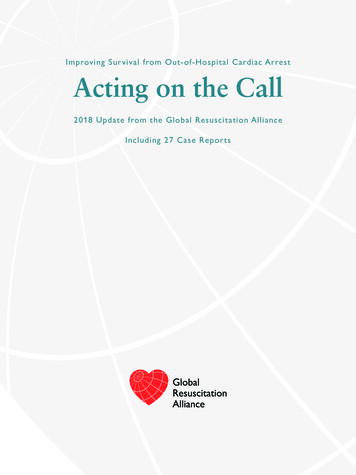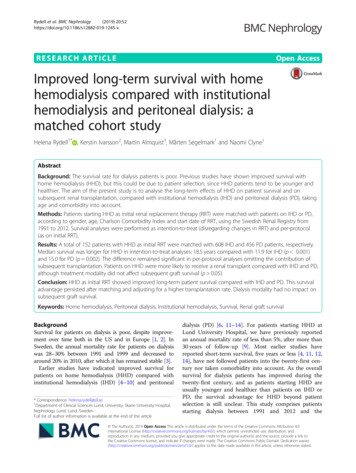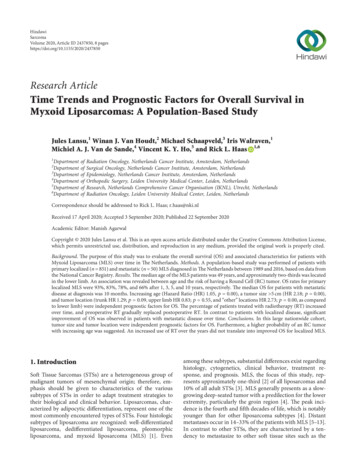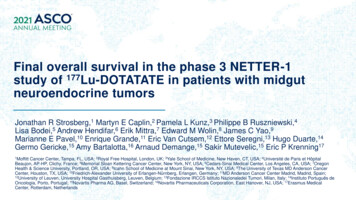
Transcription
Final overall survival in the phase 3 NETTER-1177study of Lu-DOTATATE in patients with midgutneuroendocrine tumorsJonathan R Strosberg,1 Martyn E Caplin,2 Pamela L Kunz,3 Philippe B Ruszniewski,4Lisa Bodei,5 Andrew Hendifar,6 Erik Mittra,7 Edward M Wolin,8 James C Yao,9Marianne E Pavel,10 Enrique Grande,11 Eric Van Cutsem,12 Ettore Seregni,13 Hugo Duarte,14Germo Gericke,15 Amy Bartalotta,16 Arnaud Demange,15 Sakir Mutevelic,15 Eric P Krenning171MoffittCancer Center, Tampa, FL, USA; 2Royal Free Hospital, London, UK; 3Yale School of Medicine, New Haven, CT, USA; 4Université de Paris et HôpitalBeaujon, AP-HP, Clichy, France; 5Memorial Sloan Kettering Cancer Center, New York, NY, USA; 6Cedars-Sinai Medical Center, Los Angeles, CA, USA; 7OregonHealth & Science University, Portland, OR, USA; 8Icahn School of Medicine at Mount Sinai, New York, NY, USA; 9The University of Texas MD Anderson CancerCenter, Houston, TX, USA; 10Friedrich-Alexander University of Erlangen-Nürnberg, Erlangen, Germany; 11MD Anderson Cancer Center Madrid, Madrid, Spain;12University of Leuven, University Hospital Gasthuisberg, Leuven, Belgium; 13Fondazione IRCCS Istituto Nazionaledei Tumori, Milan, Italy; 14Instituto Português deOncologia, Porto, Portugal; 15Novartis Pharma AG, Basel, Switzerland; 16Novartis Pharmaceuticals Corporation, East Hanover, NJ, USA; 17Erasmus MedicalCenter, Rotterdam, Netherlands
2Introduction In the primary analysis of NETTER-1, 177Lu-DOTATATE significantly prolonged PFSversus high-dose long-acting octreotide (HR, 0.18 [95% CI: 0.11, 0.29]; p 0.0001),in patients with advanced, progressive, well-differentiated, somatostatin receptor-positivemidgut neuroendocrine tumors. OS was a key secondary endpoint. Data cut-off for this protocol-specified final analysis of OS was January 18, 2021, whichwas 5 years after the last patient was randomized and following 142 deaths.CI, confidence interval; HR, hazard ratio; OS, overall survival; PFS, progression-free survival.Jonathan R Strosberg
3NETTER-1: overall survival in the intention-to-treat populationCI, confidence interval; HR, hazard ratio; OS, overall survival.Jonathan R Strosberg
4NETTER-1: overall survival accounting for cross-over toradioligand therapy in the control arm (RPSFT method)In the controlarm, 41/114patients (36.0%)crossed over toradioligandtherapy duringlong-termfollow-up.CI, confidence interval; HR, hazard ratio; OS, overall survival; RPSFT, rank-preserving structural failure time.Jonathan R Strosberg
5NETTER-1: safety A total of 2/111 177Lu-DOTATATE-treated patients (1.8%) developed MDS. No new cases of MDS or acute leukemia were reported during long-term follow-up. During the study, most nephrotoxicity in 177Lu-DOTATATE-treated patients wasmild or moderate. 45/111 patients (40.5%) had grade 1 or 2 events and 6/111 patients (5.4%) had grade 3events.MDS, myelodysplastic syndrome.Jonathan R Strosberg
6NETTER-1: key findings and conclusions In the phase 3 NETTER-1 study, with a median follow-up of more than 6.3 years, the prespecified final analysis of OS(secondary endpoint) in the ITT population did not reach statistical significance (HR, 0.84 [95% CI: 0.60, 1.17]; p 0.30,two-sided), potentially impacted by a high rate of cross-over (36%) of patients in the control arm to radioligand therapy(mostly 177Lu-DOTATATE). Median OS was 48.0 months in the 177Lu-DOTATATE arm and 36.3 months in the control arm. Two 177Lu-DOTATATE-treated patients (1.8%) developed MDS, consistent with previous reports1–5 – no new cases ofMDS or acute leukemia were reported during long-term follow-up. No new safety signals emerged during long-term follow-up. In overall conclusion, the NETTER-1 study demonstrated that treatment with 177Lu-DOTATATE led to a clinically andstatistically significant improvement in PFS as a primary endpoint (HR, 0.18 [95% CI: 0.11, 0.29]; p 0.0001) as well asa clinically meaningful improvement in median OS of 11.7 months versus high-dose long-acting octreotide.CI, confidence interval; HR, hazard ratio; ITT, intention-to-treat; MDS, myelodysplastic syndrome; OS, overall survival; PFS, progression-free survival.1. Sabet A et al. J Nucl Med 2013;54:1857–61; 2. Bodei L et al. Eur J Nucl Med Mol Imaging 2015;42:5–19; 3. Brabander T et al. Clin Cancer Res 2017;23:4617–24; 4. Garske-Roman U et al. Eur J Nucl Med Mol Imaging 2018;45:970–88;5. Zandee WT et al. J Clin Endocrinol Metab 2019;104:1336–44.Jonathan R Strosberg
7Acknowledgements The authors thank the patients and their families, and all site investigators and personnel whoparticipated in the study. The authors thank Maurizio Franco Mariani of Advanced Accelerator Applications (AAA), aNovartis company, for his instrumental contributions to the study design, writing of the protocoland conduct of the study. This study was funded by AAA, a Novartis company. Under the direction of the authors, Dr Charlie Foster from Oxford PharmaGenesis providedmedical writing assistance, which was funded by AAA, in accordance with Good PublicationPractice (GPP3) guidelines (https://www.ismpp.org/gpp3).Jonathan R Strosberg
Final overall survival in the phase 3 NETTER-1 study of 177Lu-DOTATATE in patients with midgut neuroendocrine tumors Jonathan R Strosberg,1 Martyn E Caplin,2 Pamela L Kunz,3 Philippe B Ruszniewski,4 Lisa Bodei,5 Andrew Hendifar,6 Erik Mittra,7 Edward M Wolin,8 James C Yao,9 Marianne E Pavel,10 Enri



